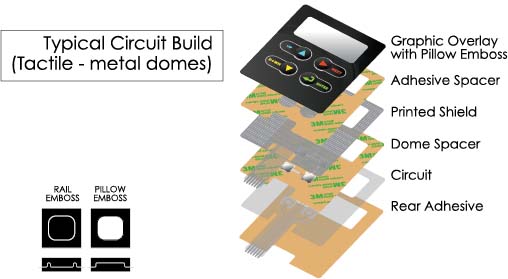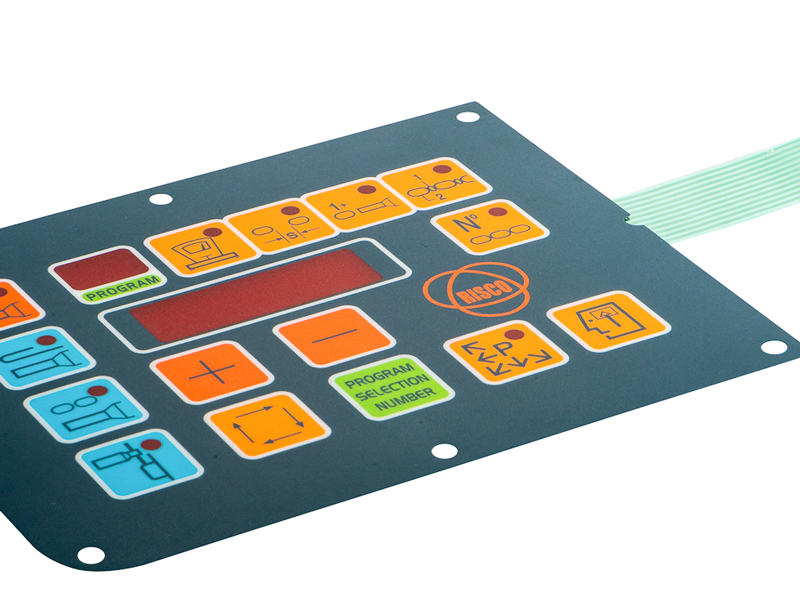The Impact of Membrane Switches on User Interface and Device Functionality
The Impact of Membrane Switches on User Interface and Device Functionality
Blog Article
Understanding Membrane Changes: The Secret to Reputable and durable Controls
Membrane layer switches over represent an essential element of modern user interface style, mixing functionality with durability in various applications. These functional parts not only facilitate user interaction however are also crafted to hold up against the roughness of demanding environments, from clinical tools to industrial machinery. Understanding their building and construction, operation, and the myriad benefits they provide is vital for designers and developers alike. As we check out the intricacies of membrane layer switches, it becomes clear that their function in boosting control systems is both complicated and profound, raising concerns regarding just how ideal to utilize their capacities in future technologies.
What Are Membrane Buttons?
Membrane switches are an innovative option in the realm of customer interface technology, combining performance and design effortlessly. These devices function as a user interface in between individuals and electronic systems, incorporating a number of components right into a portable format. Generally created from adaptable, slim layers of materials, membrane layer switches are made to react to touch, enabling customers to engage with equipment and digital tools successfully.
The primary components of a membrane layer button include a printed circuit layer, graphic overlay, and a spacer layer that protects against unintended activation. The graphic overlay can be personalized to show brand identification or individual choices, boosting aesthetic appeals while ensuring usability. Membrane layer switches are frequently utilized in various applications, consisting of medical tools, customer electronic devices, and industrial tools, owing to their longevity and resistance to ecological aspects such as dampness and dirt.
Among the key advantages of membrane layer switches is their capability to endure damage, making them excellent for high-traffic atmospheres. Furthermore, they are light-weight and require very little room, enabling for innovative layouts in product growth. Generally, membrane layer changes stand for a effective and useful selection for contemporary digital user interfaces, marrying technology with user-centric layout concepts.

Exactly How Membrane Layer Switches Job
The operation of membrane changes joints on a basic yet effective device that converts individual input into digital signals. When an individual presses the button, the leading layer flaws, enabling a conductive component in the circuit layer to make call with a corresponding conductive pad on the bottom of the visuals overlay.
The layout of membrane layer buttons can vary, however they usually integrate domes or tactile elements to supply responses to the customer, improving the total experience. The products utilized in membrane buttons, such as polyester or polycarbonate, contribute to their sturdiness and resistance to ecological variables, consisting of moisture and dust. The printed circuits are typically encapsulated, which shields them from wear and tear over time.

Advantages of Membrane Layer Switches
Among the primary benefits of membrane buttons is their adaptability in style, allowing them to be personalized to fulfill details individual requirements and visual needs. This versatility extends to numerous markets, where different forms, sizes, and shades can be employed to enhance link individual communication and aesthetic charm.
Furthermore, membrane layer buttons are known for their sturdiness. Built from robust materials, they are resistant to dirt, wetness, and physical wear, which significantly expands their life expectancy compared to conventional mechanical switches. This toughness makes them especially ideal for high-traffic settings and applications needing durability.

Additionally, membrane layer buttons provide a streamlined profile, leading to a thinner design that can be integrated right into numerous devices without adding mass. This function not only enhances the visual allure but also adds to a more ergonomic item style.

Applications of Membrane Switches
Versatile and straightforward, membrane layer buttons locate applications across a vast array of markets, consisting of medical tools, consumer electronics, and industrial devices. In the medical field, these switches are essential to gadgets such as diagnostic devices, client monitoring systems, and infusion pumps, where reliability and ease of cleansing are crucial. Their capability to endure rough settings and keep functionality makes them optimal for such applications.
In customer electronic devices, membrane layer buttons are used in items like microwaves, washing makers, and remotes - membrane switch. Their smooth design enables instinctive interface, enhancing the overall user experience while offering longevity and resistance to tear and put on
Industrial equipment additionally profits from membrane layer buttons, especially in control panels for machinery and automation systems. These buttons offer defense versus dirt and moisture, ensuring regular performance in difficult settings. Their adjustable features enable manufacturers to tailor them to certain operational needs, improving efficiency and performance.
Picking the Right Membrane Change
When choosing a membrane layer button, it is essential to consider various aspects that affect efficiency and viability for details applications. The key considerations include ecological problems, tactile feedback, durability, and design specs.
First, assess the operating atmosphere; buttons exposed click to moisture, chemicals, or extreme temperatures call for certain materials to make certain durability and functionality. Next off, examine the requirement for responsive feedback. Relying on individual interaction, some applications may gain from a responsive reaction to verify activation, while others may choose a non-tactile layout for aesthetic reasons.
Durability is an additional vital element; membrane buttons must be made to hold up against constant use, influences, and abrasion. Make certain the picked button can sustain the anticipated lifecycle, specifically in high-usage scenarios.
Verdict
In verdict, membrane layer switches over work as crucial elements in the design of long lasting and reliable control systems throughout numerous markets. Their small layout, combined with robust building and personalized functions, boosts customer communication while ensuring long life popular atmospheres. The adaptability of membrane layer switches over permits tailored remedies that fulfill particular functional needs, enhancing their significance in modern technology. membrane switch. As industries remain to progress, the relevance of incorporating effective membrane layer button solutions can not be overemphasized.
Membrane layer switches stand for a crucial element of modern-day user interface style, blending capability with strength in different applications.Membrane layer switches are an innovative solution in the world of customer interface modern technology, integrating functionality and layout flawlessly. Commonly constructed from versatile, thin layers of materials, membrane buttons visit here are developed to respond to touch, making it possible for individuals to interact with machinery and digital tools efficiently.
The design of membrane switches can differ, yet they usually integrate domes or tactile components to give responses to the user, improving the total experience.In verdict, membrane layer switches offer as crucial components in the layout of resilient and reliable control systems across various industries.
Report this page